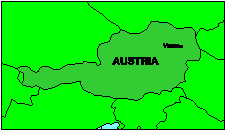

Austria, 4 Trade Ducat, 1915
13.9636 g., .986 GOLD, .4430 oz AGW., KM2276, BU
Brilliant Uncirculated condition. Piece of rare beauty.
The territories later known as Austria were
overrun in pre-Roman times by various tribes, including the Celts. Upon the fall of the
Roman empire, the country became a margravate of Charlemagne's Empire. Premysl Otaker,
King of Bohemia, gained possession in 1252, only to lose to territory to Rudolf of
Hasbsburg in 1276. Thereafter, until World war I, the story of Austria was conducted by
the ruling Habsburgs.
Francis I died on August 18, 1765. His wife
Maria Theresa, decreed on July 21, 1766 that coins would be issued with the portrait of
Francis and bearing the year of his death (1765). Also to be included were letters of the
alphabet to indicate the actual year of issue: i.e. A-1766, G-1772, P-1780.
The posthumous coins were issued rather
erratically as to denominations, years and mints. 5 denominations were made and 7 mints
were used. Only the Ducat and 20 Kreuzer were made until 1780, the year in which Maria
Theresa died. The other denominations were 3, 10 and 17 Kreuzer.
During World war I, the Austro-Hungarian Empire
was one of the Central Powers with Germany, Bulgaria and Turkey. At the end of the war,
the Empire was dismembered and Austria established as independent republic. In March,
1938, Austria was incorporated into Hitler's short-lived Greater German Reich. Allied
forces occupied Austria in April, 1945, and subsequently divided it into 4 zones of
military occupation. On May 15, 1955, the 4 powers formally recognized Austria.
 |